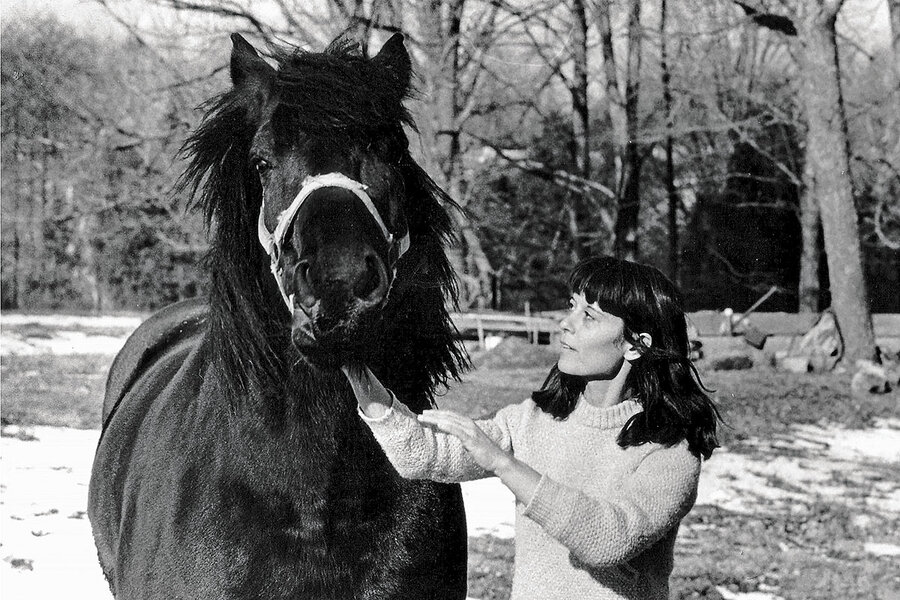My history on horseback
Loading...
On a potentially foolish whim I recently booked a session at a local stable with a friend and accomplished rider who wanted to take advantage of a two-for-one rate. I hadn’t been on anything but a sunning draft horse in years, and not regularly on a real riding horse since the mid-1970s. That’s when I lived in Devon, England, and helped cover my expenses by milking cows, mucking out my host Audrey’s barn, and helping to exercise her Exmoor ponies on the local lanes and moors every day. I became a fairly proficient rider, comfortable at trots, canters, and uphill gallops. I even delivered the Sunday paper locally and alone on horseback, clopping into cobbled cow yards to hand the bundles down to farmers ever out early, too.
One of my favorite memories of that year is prominent in my brief history on horseback. The fellow I milked for asked me to walk out to the field across the lane and ride back a tame pony that needed some attention. Off I went, and back I came on one of the two pasturing Exmoors.
“Good on you,” he said, eyeing me carefully, with a distinct stab of concern. “But that’s the wild one. She’s never been ridden before.” Back I went to make the exchange, feeling like Annie Oakley without her pistols.
Once back in the States, after such complete freedom with horses, I couldn’t imagine tolerating the protocols, rules, and regulations of trail rides and formal lessons. My riding came to a halt. Only after taking up dairy farming in 1990 did I relate intimately with horses again, first with big black Percheron Ben, whom I’d ride bareback to collect the cows, often falling off. He was too broad for a saddle and tended to bolt sideways as leaves fell or butterflies fluttered past his ever-alert eyes. I learned how to land without breaking any bones. I later worked with two teams of Belgians, hauling logs and raking hay. Sometimes I’d just sit on their ever-placid backs for the sheer pleasure of their scent and warmth.
Those days are long gone. By the time Lydia asked me to share a riding outing with her I felt like a complete novice. But then again, why say no?
And so there we were, our two quarter horses tethered and waiting, ears pricked.
One of the best ways to get to know a horse is with a currycomb, and my horse, a beautiful bay mare, stood quietly as I prepared her in this way for the saddle and bridle. Legend even allowed me to lift and clean her hooves. Once I’d saddled her and led her out to the riding ring, I made it known to her and my instructor that I needed to get used to everything again. I needed to take it slowly.
Stirrups adjusted, I was suddenly up and on. Dorothy, holding a rope tied to Legend’s bridle, said encouragingly, “Well, I see you’ve done that before!”
Confidence rising, I gave Legend plenty of slack with the reins. (Dorothy still held the rope.) Off we went at a sedate walk.
Lydia was cantering on her own around the ring before I worked myself into a free trot with extra bounces in the saddle between brief periods of smooth posting. Dorothy continued to encourage, calling, “You have the muscle memory, you’re doing just fine. Keep going!”
I finally settled into that old comfort zone of feeling a horse’s rhythm and letting it be my guide. The gentlest nudges with my knees turned her in the directions I wanted to go. Her neck began to glisten slightly with sweat.
“Hands lower, heels down,” came Dorothy’s oft-repeated reminder.
It was a sawdust ring, but I could almost see the moors folding toward the sky in the distance. I could hear Audrey’s voice telling me to keep my hands down and heels back.
The final few minutes were spent in a walk, as Legend cooled and Dorothy and I chatted.
A final brush, treats of carrots and apples, and winter blanketing completed the hour, and I walked out to pasture Legend with her stablemates, who’d been whinnying for her off and on.
It will take a few more sessions before I canter again. But with this horse, I’m sure I’ll get there, hands down, heels back, and more memories bubbling up. If Audrey were still here I’d be writing a long letter to her about all this. But she was there, somehow, in Dorothy. And my old Exmoor pony, Morag, was too, in Legend.







